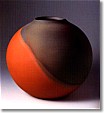|
List of Ceramists Honored as
Living National Treasures (as of August 2004)
|
|
|
Name
|
Style
|
Work
|
Year Designated
|
|
Tomimoto Kenkichi
1886-1963
|
overglaze enamel
(iro-e jiki)
|

|
1955
|
|
Ishiguro Munemaru
1893-1968
|
iron glazes
(tetsu-yu)
|

|
|
Hamada Shoji
1894-1978
|
folk craft
(mingei)
|

|
|
Arakawa Toyozo
1894-1985
|
Shino and Setoguro
(black Seto)
|

|
|
Kaneshige Toyo
1896-1967
|
Bizen ware
|

|
1956
|
|
Kato Hajime
1900-1968
|
overglaze enamel
(iro-e jiki)
|

|
1961
|
|
Fujiwara Kei
1899-1983
|
Bizen ware
|

|
1970
|
|
Miwa Kyuwa (Kyusetsu X)
1895-1981
|
Hagi ware
|

|
|
Nakazato Muan
(Taroemon XII)
1895-1985
|
Karatsu
|

|
1976
|
|
Kondo Yuzo
1902-1985
|
underglaze
blue cobalt
(sometsuke)
|

|
1977
|
|
Tsukamoto Kaiji
1912-1990
|
white and bluish
porcelain
(hakuji, seihakuji)
|

|
1983
|
|
Miwa Kyusetsu Xl
1910-
|
Hagi
|

|
|
Shimizu Uichi
1926-2004
|
iron glaze
(tetsu-yu)
|

|
1985
|
|
Kinjo Jiro
1912-
|
Ryukyu wares
|

|
|
Tamura Koichi
1918-1987
|
iron designs
(tetsu-e)
|

|
1986
|
|
Fujimoto Yoshimichi
1919-1992
|
overglaze enamel
porcelain
(iro-e jiki)
|

|
|
Yamamoto Toshu
1906-1994
|
Bizen ware
|

|
1987
|
|
Imaizumi Imaemon XIII
1926 - 2001
|
overglaze enamel
decoration
(iro-e jiki)
|

|
1989
|
|
Matsui Kosei
1927 - 2003
|
mutli-colored
marbled ware
(neriage)
|

|
1993
|
|
Suzuki Osamu (Kura)
1934 -
|
Shino ware
|

|
1994
|
|
Kato Takuo
1917 -
|
three-colored
ware (sansai)
|

|
1995
|
|
Inoue Manji
1929 -
|
white porcelain
(hakuji)
|

|
|
Fujiwara Yu
1932 - 2001
|
Bizen ware
|

|
1996
|
|
Shimaoka Tatsuzo
1919 -
|
folk craft
rope inlaid wares
(mingei jomon
zogan)
|

|
|
Miura Koheiji
1933 -
|
celadon (seiji)
|

|
1997
|
|
Tokuda Yasokichi III
1933 -
|
colorful porcelain
Kutani
(saiyu jiki)
|

|
|
Yamada Jozan III
1924 -
|
Tokoname ware
tea pots
(kyusu)
|

|
1998
|
|
Sakaida Kakiemon XIV
1934 -
|
overglaze enamel decorative porcelain
(iro-e jiki)
|
|
2001
|
|
Yoshita Minori
1932 -
|
underglaze gold decoration (yuri-kinsai)
|
|
2001
|
|
Ito Sekisui V
1941 -
|
Mumyo-yaki
wares made
with red ocher
clay from
Sadogashima Island
|

|
2003
|
|
Isezaki Jun
1936 -
|
Bizen
ware
|

|
2004
|
|
Hara Kiyoshi
1936 -
|
iron glaze
(tetsu-yu)
|

|
2005
|